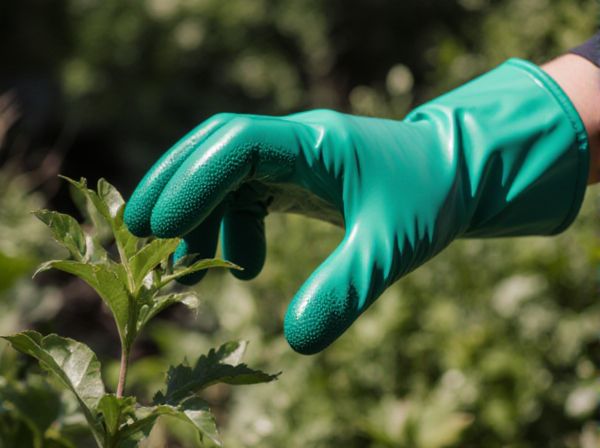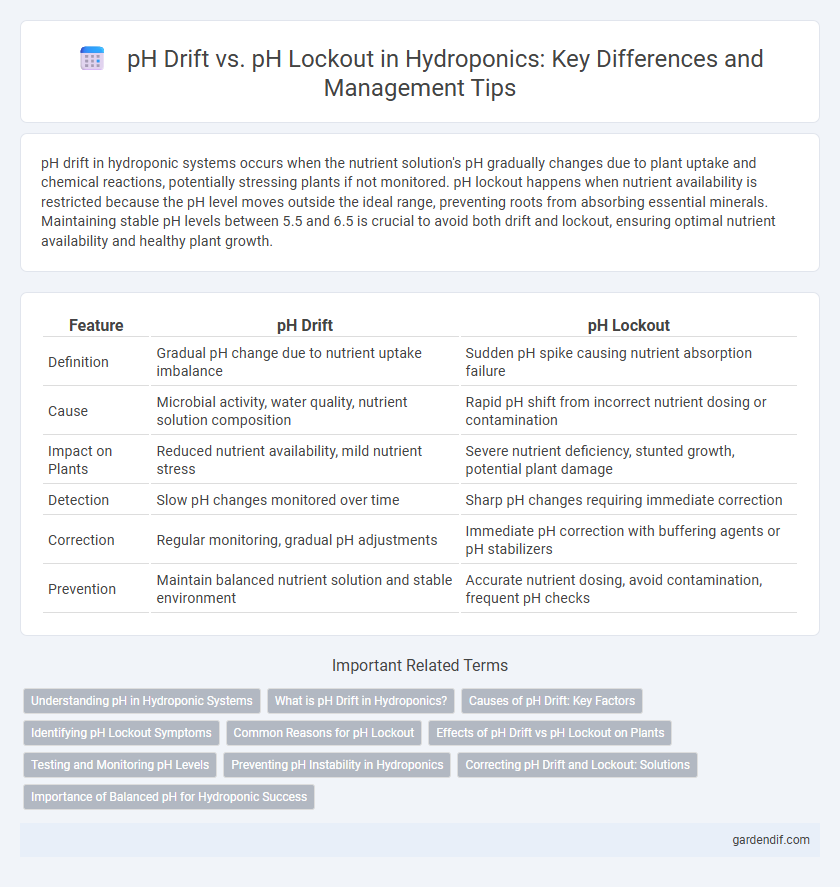
pH Drift vs pH Lockout Illustration
pH drift in hydroponic systems occurs when the nutrient solution's pH gradually changes due to plant uptake and chemical reactions, potentially stressing plants if not monitored. pH lockout happens when nutrient availability is restricted because the pH level moves outside the ideal range, preventing roots from absorbing essential minerals. Maintaining stable pH levels between 5.5 and 6.5 is crucial to avoid both drift and lockout, ensuring optimal nutrient availability and healthy plant growth.
Table of Comparison
| Feature | pH Drift | pH Lockout |
|---|---|---|
| Definition | Gradual pH change due to nutrient uptake imbalance | Sudden pH spike causing nutrient absorption failure |
| Cause | Microbial activity, water quality, nutrient solution composition | Rapid pH shift from incorrect nutrient dosing or contamination |
| Impact on Plants | Reduced nutrient availability, mild nutrient stress | Severe nutrient deficiency, stunted growth, potential plant damage |
| Detection | Slow pH changes monitored over time | Sharp pH changes requiring immediate correction |
| Correction | Regular monitoring, gradual pH adjustments | Immediate pH correction with buffering agents or pH stabilizers |
| Prevention | Maintain balanced nutrient solution and stable environment | Accurate nutrient dosing, avoid contamination, frequent pH checks |
Understanding pH in Hydroponic Systems
pH drift in hydroponic systems occurs when nutrient solution pH gradually changes due to plant uptake and microbial activity, impacting nutrient availability. pH lockout happens when pH shifts beyond the optimal range, causing nutrient ions to become insoluble and unavailable, leading to deficiencies. Maintaining a stable pH between 5.5 and 6.5 is critical for optimal nutrient absorption and healthy plant growth in hydroponics.
What is pH Drift in Hydroponics?
pH drift in hydroponics refers to the gradual change in nutrient solution pH over time, often caused by plant uptake, microbial activity, or chemical reactions within the reservoir. This drift can lead to nutrient imbalances, affecting plant growth and nutrient availability. Managing pH drift is essential to maintain optimal hydroponic conditions and prevent nutrient lockout, where plants cannot absorb critical minerals.
Causes of pH Drift: Key Factors
pH drift in hydroponic systems occurs primarily due to nutrient uptake imbalances, where plants absorb ions at different rates, altering the solution's acidity. Microbial activity in the root zone can also influence pH levels by producing organic acids or consuming ions that affect pH stability. Water source and solution aeration further contribute to pH fluctuations by changing the dissolved gas concentrations, impacting the overall nutrient availability.
Identifying pH Lockout Symptoms
pH lockout occurs when nutrient uptake is inhibited due to an extreme or stagnant pH level in hydroponic systems, leading to nutrient deficiencies despite adequate nutrient availability. Symptoms of pH lockout include yellowing leaves, stunted growth, and leaf spotting, often mistaken for nutrient deficiency or toxicity. Regular monitoring and maintaining pH within the optimal range of 5.5 to 6.5 prevents lockout and ensures efficient nutrient absorption in hydroponic crops.
Common Reasons for pH Lockout
In hydroponic systems, pH lockout commonly occurs due to nutrient imbalances, over-fertilization, and inadequate buffering capacity within the growing solution. Rapid pH shifts caused by root respiration and microbial activity can exacerbate nutrient availability issues, leading to locked-out essential elements like iron and calcium. Monitoring nutrient concentrations and maintaining stable pH levels between 5.5 and 6.5 helps prevent lockout, ensuring optimal plant uptake and growth.
Effects of pH Drift vs pH Lockout on Plants
pH drift causes subtle nutrient imbalances by gradually altering the availability of essential minerals, leading to slowed plant growth and reduced yield. In contrast, pH lockout creates severe nutrient deficiencies by locking out key nutrients like iron, calcium, and magnesium, resulting in chlorosis, stunted development, and potential plant death. Maintaining a stable pH range between 5.5 and 6.5 is critical to preventing these issues and ensuring optimal nutrient uptake in hydroponic systems.
Testing and Monitoring pH Levels
Regular testing and monitoring of pH levels in hydroponic systems prevent pH drift and pH lockout, which can damage plant nutrient uptake. Utilizing precise digital pH meters or automated sensors ensures accurate real-time data for timely adjustments. Maintaining optimal pH between 5.5 and 6.5 maximizes nutrient availability and enhances crop yield quality.
Preventing pH Instability in Hydroponics
Maintaining stable pH levels in hydroponic systems is crucial to prevent pH drift, which occurs when nutrient solutions gradually change pH due to plant uptake and microbial activity. pH lockout happens when the pH level reaches an extreme range, causing nutrient deficiencies by making essential minerals unavailable to plants. Implementing buffer solutions, regular monitoring with pH meters, and adjusting nutrient concentrations help prevent pH instability, ensuring optimal nutrient absorption and healthy plant growth in hydroponics.
Correcting pH Drift and Lockout: Solutions
Addressing pH drift in hydroponic systems involves continuous monitoring and adjusting nutrient solutions with buffer additives like potassium bicarbonate to stabilize pH levels between 5.5 and 6.5 for optimal nutrient uptake. Correcting pH lockout requires flushing the system with a pH-neutral or slightly acidic solution to dissolve nutrient precipitates and restore root absorption efficiency. Implementing automated pH controllers and regular calibration of pH meters significantly enhances precision in maintaining stable hydroponic environments.
Importance of Balanced pH for Hydroponic Success
Maintaining a balanced pH in hydroponic systems prevents issues like pH drift, where nutrient solution pH gradually changes, and pH lockout, where extreme pH levels inhibit nutrient uptake by plants. Optimal pH ranges between 5.5 and 6.5 maximize nutrient availability and promote healthy root development. Consistent monitoring and adjustment of pH ensure nutrient solutions support plant growth effectively, enhancing overall hydroponic yield and crop quality.
pH Drift vs pH Lockout Infographic

 gardendif.com
gardendif.com